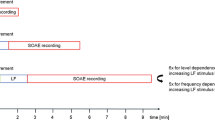Abstract
The bioelectrical activity of the cochlea, without any ipsilateral acoustic stimulation, was recorded in awake guinea pigs (GPs) between electrodes chronically implanted at the round window (RW) and the skull. Measuring its power in the band centered around 1.0 kHz (0.5–2.5 kHz) provided an indirect measure of the ensemble background (EBA) activity of the eighth nerve. Contralateral white-noise (CLWN) stimulation reduced this EBA, presumably by activation of medial olivocochlear fibers. The aim of the investigation was to validate measurements of EBA and of its contralateral suppression in order to study the medial efferent function. The first goal was to find the best conditions for recording the EBA in the absence of ipsilateral stimulation and for studying its suppression by contralateral acoustic stimulation, which implies that no noise was generated by the experimental animal. Thus recordings were compared in normal, awake GPs and in GPs under sedation with xylazine, anesthetized with a combination of xylazine and ketamine, and with and without temperature regulation. In order to monitor the effects of sedation and anesthesia, the recordings were analyzed not only in the 0.5- to 2.5-kHz frequency band but also in the other frequency bands, 5–50 Hz, 50–150 Hz, and 150–500 Hz, which presumably include general central and neuromuscular contributions. The results show that sedation with xylazine accompanied by regulation of body temperature does not affect the EBA value nor its contralateral suppression. Nevertheless, anesthesia should be avoided, even with control of body temperature. The second goal of this study was to identify the specific cochlear contribution to the raw RW signal. Thus recordings were performed in normal and deafened animals and analyzed in the frequency band 0.5–2.5 kHz and also in the other frequency bands of 5–50 Hz, 50–150 Hz, and 150–500 Hz. The results indicate that most of the cochlear activity lies in the frequency band 0.5–2.5 kHz, with also some minor contribution coming from the 150- to 500-Hz band. Analysis and comparison of power values in the different conditions indicate that specific cochlear EBA power was about 60 μV2. From a commonly accepted mean background discharge rate of 50 spikes/s (sp/s), the EBA power without CLWN should have been around 4.4 μV2 if the fibers’ activity was random. This difference suggests that there is probably some degree of synchrony between individual fibers. There was a reduction of approximately 45% during CLWN stimulation. This suppression might correspond to a reduction in both discharge rate and synchrony of the fibers.
Similar content being viewed by others
Author information
Authors and Affiliations
Additional information
Received: 28 January 1996 / Accepted: 10 April 1997
Rights and permissions
About this article
Cite this article
da Costa, D., Erre, JP., de Sauvage, R. et al. Bioelectrical cochlear noise and its contralateral suppression: relation to background activity of the eighth nerve and effects of sedation and anesthesia. Exp Brain Res 116, 259–269 (1997). https://doi.org/10.1007/PL00005754
Issue Date:
DOI: https://doi.org/10.1007/PL00005754




